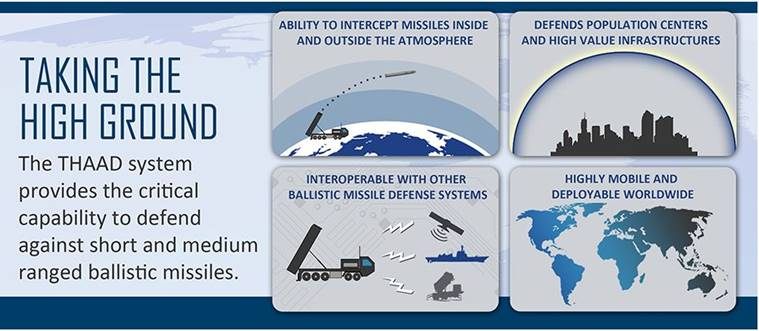THAAD, UNIFIL and Dragon Drones | 14 Oct 2024
Why in News?
Recently, the United States sent a THAAD battery to Israel, and Israeli tanks attacked UNIFIL in Lebanon.
- In another development, dragon drones are being used by both sides in the Russia-Ukraine war.
What is the Terminal High Altitude Area Defence (THAAD)?
- Overview of THAAD: THAAD is an advanced US anti-ballistic missile system designed to intercept and destroy short, medium, and intermediate-range missiles.
- It uses a "hit-to-kill" approach where an interceptor missile destroys its target by directly colliding with it, using sheer impact force rather than explosives.
- However, it cannot detect low flying objects like drones.
- Development History: The US developed THAAD after Iraq's Scud missile attacks during the 1991 Gulf War, where many American soldiers were killed.
- Deployment of THAAD: In 2008, the US deployed an early missile warning radar, a part of the THAAD system to Israel. Similar deployments were also made in 2012 and 2019 to boost Israel's ability to intercept missiles.
What are Dragon Drones?
- About Dragon Drones: Dragon drones are deadly UAVs equipped with thermite and rain down fire from sky.
- Thermite is a mixture of aluminium and iron oxide, developed to weld railroad tracks.
- Working Mechanism of Dragon Drones: Thermite is ignited by an electrical fuse and triggers a self-sustaining reaction that is incredibly difficult to extinguish.
- It can burn various materials, including military vehicles, trees, and even underwater.
- Deployment in the Russia-Ukraine War: Ukrainian forces used them to ignite the vegetation that Russian troops use for cover exposing them to direct attack.
- Russia soon adopted the use of dragon drones in retaliation.
- History of Thermite in Warfare: During World War I, German zeppelins (aircraft without wings) dropped thermite-laden bombs which were considered an innovation at the time.
- In World War II, both the Allied and Axis powers incorporated thermite into their incendiary bombs and hand grenades.
- Incendiary weapons are designed to ignite objects or cause burns and respiratory injuries through flame and heat.
- Legal Status of Thermite in Warfare: Thermite use in war is not banned under international law, but using incendiary weapons against civilians is prohibited by the Convention on Certain Conventional Weapons.
- Protocol III of the Convention on Certain Conventional Weapons restricts their use to military targets only.
What is the United Nations Interim Force in Lebanon (UNIFIL)?
- Breach UNIFIL Base: Two Israeli Merkava tanks burst through the gates of a UNIFIL base in southern Lebanon and released toxic smoke, leading to the illness of 15 UN peacekeepers.
- The Israeli Prime Minister urged the withdrawal of UNIFIL troops from Lebanon's combat zones, claiming their presence indirectly shields Hezbollah.
- Violations of International Law: UNIFIL described Israel’s attacks as violations of international humanitarian law and Resolution 1701, which ensures peacekeepers' freedom of movement.
- UNIFIL's Role: Established in 1978, UNIFIL is responsible for enforcing Resolution 1701, which mandates that only Lebanese state forces and UNIFIL be present between the Blue Line and the Litani river.
- Resolution 1701 was adopted unanimously in 2006, and aims to end hostilities between Hezbollah and Israel.
- Blue Line: The Blue Line extends 120 km along Lebanon's southern frontier and Israel's northern border.
- It is not a border, but a line of withdrawal. It was set by the United Nations in 2000 for confirming the withdrawal of Israeli forces from the south of Lebanon.
UPSC Civil Services Examination, Previous Year Questions (PYQs)
Prelims
Q. What is “Terminal High Altitude Area Defense (THAAD)”, sometimes seen in the news? (2018)
(a) An Israeli radar system
(b) India’s indigenous anti-missile programme
(c) An American anti-missile system
(d) A defence collaboration between Japan and South Korea.
Ans: (c)
Q. Mediterranean Sea is a border of which of the following countries? (2017)
- Jordan
- Iraq
- Lebanon
- Syria
Select the correct answer using the code given below:
(a) 1, 2 and 3 only
(b) 2 and 3 only
(c) 3 and 4 only
(d) 1, 3 and 4 only
Ans: (c)

